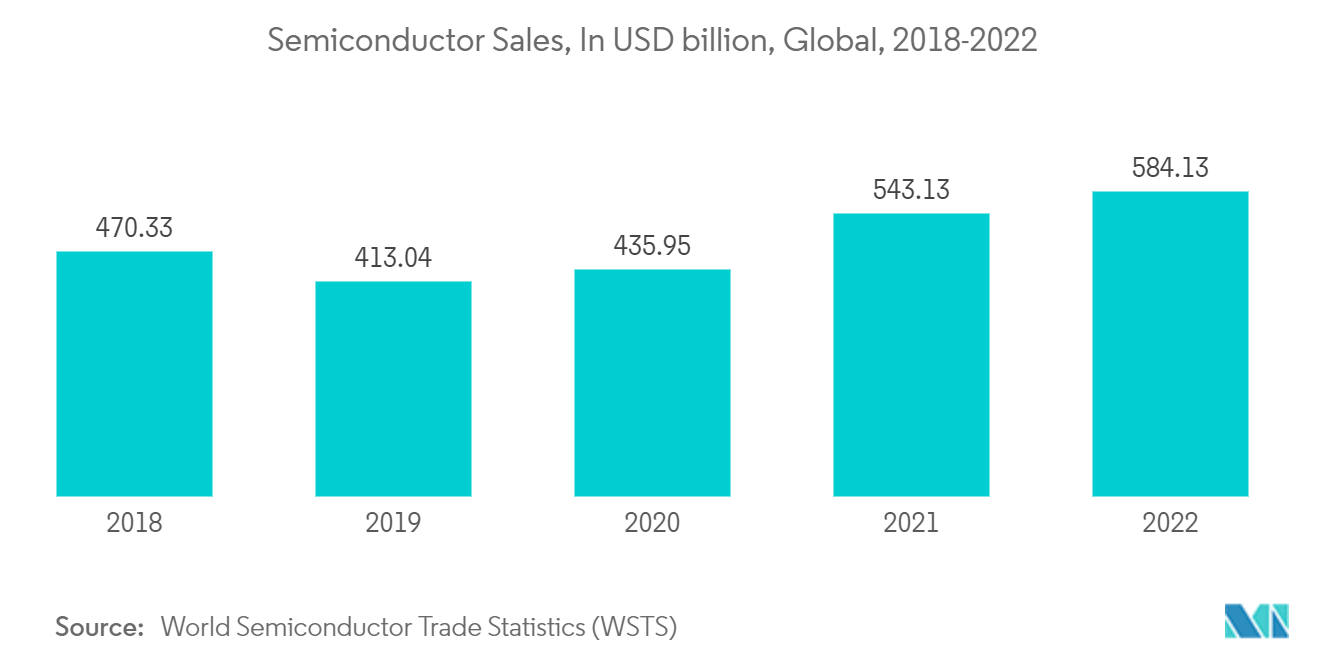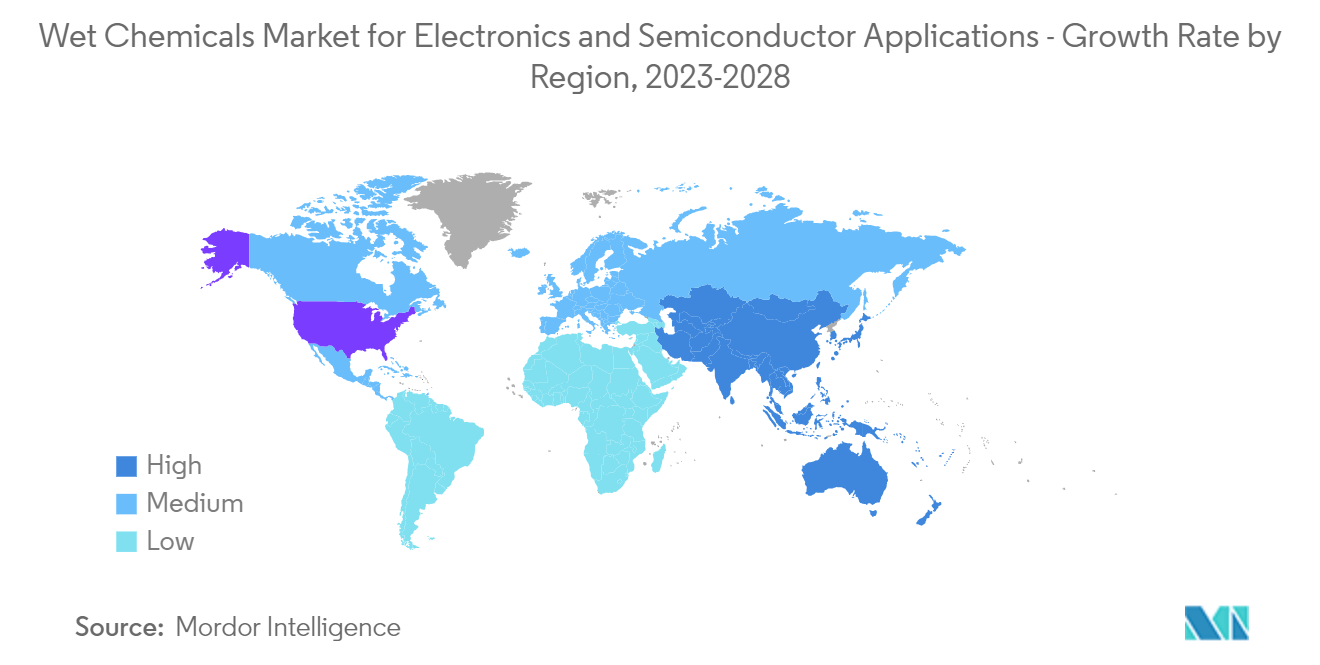Market Trends of Wet Chemicals Industry For Electronics And Semiconductor Applications
Increasing Demand Semiconductor Applications
- Wet chemicals are widely used in the production of semiconductors. They are used in both cleaning and etching applications. The production of semiconductors is growing at a staggering pace due to rapid growth from various advancements such as artificial intelligence (AI), quantum computing, and 5G networks, which are estimated to drive the market for wet chemicals during the forecast period.
- According to World Semiconductor Trade Statistics, the global semiconductor market accounted for USD 580 billion in 2022, registering a growth rate of 4.4% compared to USD 555.89 billion in 2021.
- According to the Semiconductor Industry Association (SIA), global semiconductor sales in 2022 rose by 3.2% despite the slowdown in the second half of the year caused by the economic slowdown and inflation.
- According to the survey conducted by the association, the global demand for semiconductor manufacturing capacity is projected to increase by 56% by 2030.
- Moreover, under the United States Innovation and Competition Act (USICA), the US government has made significant investments in chip production and research in the United States.
- In North America, the United States launched the CHIPS and Science Act in August 2022 to support domestic production and innovation in the semiconductor industry. The government announced an investment of USD 52 billion in chip manufacturing incentives and research investments. This also includes an investment tax credit for semiconductor manufacturing and semiconductor equipment manufacturing.
- In Asia-Pacific, India launched a comprehensive program for the development of semiconductors and display manufacturing ecosystems in the country. The government announced an outlay of INR 76,000 crore (~USD 10 billion).
- The growing demand for semiconductors is estimated to drive the demand for wet chemicals during the forecast period.

The Asia-Pacific Region is Expected to Dominate the Market
- The Asia-Pacific region dominated the global market. With the growing demand for electronics in countries such as China, India, and Japan, the usage of wet chemicals is increasing in the region.
- China is the most extensive base for the production of electronics in the world. Electronic products, such as smartphones, TVs, and other personal devices, recorded the highest growth in the electronics segment. China is the largest electronics manufacturer in the world. China is actively manufacturing electronic products, such as smartphones, TVs, wires, cables, portable computing devices, gaming systems, and other personal devices.
- The Chinese electronics market grew by 13% in 2022 compared to 2021, when the market witnessed a 10% rise. The estimated growth rate for 2023 is 7%. The Chinese market is the largest in the world, even more significant than the combined markets of all industrialized countries. In 2022, the Chinese electronic industry expanded by 14%, and it is expected to grow by 8% in 2023.
- Moreover, China is the net importer of semiconductor chips, with it manufacturing less than 20% of semiconductors used. Owing to the lucrative demand in both domestic and international markets in 2022, 101 Chinese-listed semiconductor companies announced net profits in their yearly sales, indicating a positive direction for the wet chemicals used in the industry.
- The domestic Indian electronics manufacturing sector has been expanding steadily, owing to favorable government policies, such as 100% foreign direct investment (FDI), no requirement for an industrial license, and the technological transformation from manual to automatic production processes. New incentives, such as the Modified Incentive Special Package Scheme (M-SIPS) and Electronics Development Fund (EDF), were started in the country with a budget of USD 114 million for domestic electronics manufacturing in India.
- Some of the other schemes that the Government of India launched to promote electronics production are the Scheme for Promotion of Manufacturing of Electronic Components and Semiconductors (SPECS) and the Scheme for Modified Electronics Manufacturing Clusters (EMC 2.0), alongside the Production Linked Incentive (PLI). According to the PLI scheme, the government is likely to offer incentives as manufacturers increase production in India, which is expected to be USD 5.5 billion by 2025. This is likely to boost the production of electronics in the country, thereby driving the market for wet chemicals during the forecast period.
- According to the Indian Electronics and Semiconductor Association, the semiconductor market in the country is expected to be worth USD 64 billion by 2026. The Make in India initiative by the government is expected to result in investments in the semiconductor industry in the country.
- The electrical and electronics industry in Japan is one of the world's leading industries. The country is a world leader in producing computers, gaming stations, cell phones, and other key components. Consumer electronics account for one-third of the Japanese economic output. However, Japan's electronics production has declined due to stiff competition from countries such as China, India, and South Korea.
- According to the data released by the Japanese Electronics and Information Technology Industries Association (JEITA), in 2022, the total production value of the electronics industry in Japan accounted for around JPY 11,124.3 billion, displaying a rise of nearly 8% from the previous year. According to the International Trade Administration, the Japanese semiconductor market size is estimated to reach USD 51,554 million in 2023, compared to USD 43,687 million in 2021.
- All the aforementioned factors are expected to boost the overall demand for wet chemicals in the Asia-Pacific region during the forecast period.


